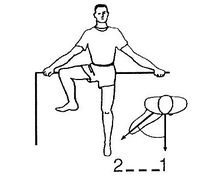Stretching
Flexibility for runners is a bit like Goldilocks; too little flexibility and you can become injured, but too much flexibility reduces your running efficiency. Stretching can help improve your flexibility and some stretching may be a useful part of your training. However, stretching can temporarily weaken your muscles. To limit the weakness, only a small amount of stretching should be part of your warm-up, with a little more after your run as part of your cool-down. If you believe in flexibility is causing you injury, then stretching to improve your range of motion should be performed well after your run.
Contents
[hide]1 Introduction
Static stretching is where a muscle is elongated to the Point Of Discomfort (POD), and held for a period of time, often between 30 seconds and 2 minutes. Dynamic stretching is where the muscle is moved through its Range Of Motion (ROM), without being held in the stretched position. Generally dynamic stretching starts off with moving through a limited Range Of Motion and builds up gradually. Normally dynamic stretching does not elongate the muscle to the Point Of Discomfort in the way that static stretching does. (Note the dynamic stretching is not "ballistic stretching". Ballistic stretching is where a muscle is bounced against the limits of its movement in an attempt to force it to stretch further.)
2 Recommended stretches
Different types of stretches should be performed at different times and for different objectives.
2.1 Warm-up
Cold muscles are prone to injury when stretched. Therefore it is best to do any stretching before running as part of the warm-up. The best approach appears to be using dynamic stretching to both warm-up and stretch the muscles. This dynamic stretching should start with a limited range of motion and build up over several repetitions until you are moving through most of your range of motion. The dynamic stretching should not have the goal of improving flexibility in the long term as this is best done at other times.
2.2 Mid-run
Gently moving a limb through its natural Range of Motion can refresh the muscles. This is different to a traditional stretch, as you are not trying to extend a muscle past its comfort point. This approach is the basis for the Morton Stretch. |

2.3 Cooldown
After the run, the muscles become delicate and stretching at this point can easily injure them. While stretching before a run does not reduce muscle soreness, I have found gentle stretching after a run can keep the muscles happier. This Cooldown stretching should not be performed with the objective of improving flexibility. Instead, the stretches should be short (5-10 seconds) and not to the Point Of Discomfort. Think of the stretches as allowing the muscles to elongate fully, rather than trying to forcibly extend them.
2.4 Improving Flexibility
Stretching to improve flexibility should be done cautiously. It is easy to overstretch a muscle and cause a slight injury that will actually cause the muscle to heal back even shorter. It is better to stretch slightly too little them slightly too much. Therefore stretches should not be to the Point Of Discomfort, but to the point where you can feel stretch without discomfort. Stretches should be held for 30 seconds or less, and repeated for a total duration of and 90 seconds or less (3x30 seconds, 6x15 seconds, 9x10 seconds, or some other combination.) Passive warming (see below) should be used.
2.5 Relieving the discomfort of being motionless
If you are motionless for some time, such as sitting at a desk or in an aircraft, stretching can relieve the discomfort. The stretches should be gentle and short; just enough to ease the muscles. Care must be taken in this situation is the muscles are cold and tight, and therefore easily overstretched.
3 Stretching and muscle weakness
Static stretching has been shown to improve flexibility[1], but causes temporary muscle weakness [2]. This stretch induced weakness can continue for two hours after the stretching. The level of weakness of the muscle depends on total length of time spent stretching the muscle. It appears that stretching a muscle for a total of 90 seconds or less reduces the stretch induced weakness. The weakness also seems to be related to the intensity of the stretch, with stretches to the Point Of Discomfort causing more weaknesses than gentler stretching.
4 Overstretching
Stretching even slightly too far can injure the muscle. This slight damage can ironically lead to further tightness and reduced Range Of Motion. It is therefore important to err on the side of caution when stretching.
5 Gentle stretching
Normally static stretching is performed to the Point Of Discomfort (POD). Some studies have used stretching to less than the POD, and have shown that this gentle stretching can actually improve flexibility slightly more than the POD stretches. Given the risk of injury from stretching too far, it seems wise to stretch slightly less rather than pushing to the limit.
6 How long to hold a static stretch
There is some evidence[3] that stretches held for longer than 30 seconds have no additional benefit. In fact, stretches held for as little as 9 seconds have shown to improve flexibility[4].
7 Passive warming
It is better to stretch warm muscles, as cold muscles can easily be injured when stretched. When stretching as part of the warm-up and cool-down, the muscles are naturally warmed by the activity. For stretching at other times however, passive warming can be used. This passive warming could be stretching in a hot room, warming the muscles using a hot water bottle, or an electric blanket.
8 Dynamic or static stretching
It is unclear from the research if dynamic stretching improves flexibility as much a static stretching, as different studies have reached different conclusions. It's also unclear if the risk of injury from stretching itself is greater or less with dynamic stretching. Therefore it seems wisest to use dynamic stretching, or very gentle short static stretching as part of the warm-up, and gentle short static stretching in the Cooldown. Longer periods of static stretching to improve flexibility could be incorporated at other times, when the muscles are not delicate from exercise, and have been warmed passively.
9 Deep stretching with PNF
PNF (Proprioceptive Neuromuscular Facilitation) is a term that covers several stretching approaches[5] that produce a deeper stretch:
- Hold and relax. A muscle is initially stretched and while the stretch is held, the muscle is consciously relaxed and then stretched further. This conscious relaxation produces a deeper stretch.
- Contract and relax. Here the muscle is initially stretched, then while the muscle is held in the stretched position, it is contracted (tightened), then relaxed, and finally stretched further. This period of muscular contraction produces a deeper stretch than 'hold and relax'.
- Antagonist contract. The antagonist muscle is the one that has the opposite direction. For instance, the quads are the antagonist of the hamstrings. This technique utilizes the fact that contracting one muscle relaxes its antagonist and vice versa. The 'antagonist contract stretch' uses a contraction of the antagonist to stretch the muscle. So to stretch the hamstring, the quads are used to apply the stretching force, rather than bending from the hips with a straight leg.
- Contract relax agonist contract. This approach combines 'contract relax' and 'antagonist contract'. The target muscle is stretched, contracted, relaxed, the antagonist is contracted and muscle stretched further. For example to stretch the hamstring, the following sequence is used:
- The leg is straightened, and the hamstring is initially stretched by bending at the waist
- The hamstring is contracted and relaxed, and then the hamstring stretch slightly further.
- The quads are contracted and relaxed, and then the hamstring stretched further again.
- The stretch is then held, with some recommending the stretch is held until the feeling of stretching is gone.
PNF stretching has been shown[5] to be an effective way of improving flexibility, and some claim 'contract relax agonist contract' to be the most effective approach. Performing a single repetition of a 'contract relax agonist contract' stretch twice a week, with a gentle contraction of the target muscle (20% of maximum) applied for 3 to 5 seconds is a recommended[5] minimum to improve flexibility. (Flexibility can be maintained by doing this stretch once a week.) While PNF stretching is effective I have concerns that it also has a higher injury risk than other forms of stretching. Over the years I have tried a variety of PNF stretching techniques, but I no longer use this approach nor do I recommend it.
10 Stretching myths
Stretching is claimed to reduce injury, reduce post-exercise muscle soreness and improve performance[6].
10.1 Injury Reduction
Running does not require the flexibility of sports like gymnastics, and generally stretching does not reduce injuries. The only exception seems to be the hamstrings, which are stretched as part of normal running. A 1999 meta-study[7] reviewed the research at the time and concluded "stretching before exercise does not reduce the risk of injury". A 2005 meta-study [8] also showed no evidence to support stretching to reduce injury. A 12 week study of 1,538 army recruits[9] showed that stretching 6 different lower leg muscles as part of pre-exercise training did not meaningfully reduce the risk of injury. A study of 10K entrants[10] showed that stretching is correlated to injury, but this may be due to injured runners being more likely to stretch. However, a study[11] of 298 (150 intervention, 148 control) Military recruits showed that hamstring stretches reduced the risk of lower limb injury as well as increasing hamstring flexibility.
10.2 Post-Exercise Muscle Soreness
The 2005 meta-study [8] showed a slight, but not statistically significant reduction in muscle soreness. A study[12] on stretching and eccentric exercise showed no reduction in Delayed Onset Muscle Soreness.
10.3 Performance
A study[13] of 19 sub-elite runners showed that 47% of the differences in Running Economy were related to Dorsiflexion of the foot and Standing External Hip Rotation flexibility, with greater flexibility being linked to lower Running Economy. (Dorsiflexion of the foot is bending the ankle so the toes move towards the shin, which is what happens when you do a calf stretch. Standing External Hip Rotation is shown below.) A study[14] of 34 international level runners showed that flexibility in 'sit and reach' test was linked to a lower Running Economy. It has also been shown[15] that stretching reduces the power of muscles, especially static stretching. However, a 10 week study[16] of 32 college students did not find that regular stretching significantly reduced Running Economy.
11 References
- Jump up ↑ The effect of time and frequency of static stretch... [Phys Ther. 1997] - PubMed - NCBI http://www.ncbi.nlm.nih.gov/pubmed/9327823
- Jump up ↑ A review of the acute effects of static a... [Eur J Appl Physiol. 2011] - PubMed - NCBI http://www.ncbi.nlm.nih.gov/pubmed/21373870
- Jump up ↑ The effect of time and frequency of static stretch... [Phys Ther. 1997] - PubMed - NCBI http://www.ncbi.nlm.nih.gov/pubmed/9327823
- Jump up ↑ Effects of static stretching on th... [J Orthop Sports Phys Ther. 1991] - PubMed - NCBI http://www.ncbi.nlm.nih.gov/pubmed/18796808
- ↑ Jump up to: 5.0 5.1 5.2 Proprioceptive neuromuscular facilitation stretch... [Sports Med. 2006] - PubMed - NCBI http://www.ncbi.nlm.nih.gov/pubmed/17052131
- Jump up ↑ The Lore of Running, page 775
- Jump up ↑ Stretching before exercise does not reduce the risk of local muscle injury: a critical review of the clinical and basic science literature http://www.ncbi.nlm.nih.gov/pubmed/10593217
- ↑ Jump up to: 8.0 8.1 Stretching Before and After Exercise: Effect on Muscle Soreness and Injury Risk http://www.ncbi.nlm.nih.gov/pmc/articles/PMC1250267/
- Jump up ↑ A randomized trial of preexercise stretching for prevention of lower-limb injury http://www.tothemaxfit.com/articles/pdf/PreexerPreventInjury.pdf
- Jump up ↑ Injuries to runners: A study of entrants to a 10,000 meter race http://ajs.sagepub.com/content/14/2/151.short
- Jump up ↑ Increasing Hamstring Flexibility Decreases Lower Extremity Overuse Injuries in Military Basic Trainees http://ajs.sagepub.com/content/27/2/173.short
- Jump up ↑ The effects of preexercise stretching on muscular soreness, tenderness and force loss following heavy eccentric exercise http://www3.interscience.wiley.com/journal/119076815/abstract
- Jump up ↑ The association between flexibility and running economy in sub-elite male distance runners http://www.ncbi.nlm.nih.gov/pubmed/8784761
- Jump up ↑ Running economy is negatively related to sit-and-reach test performance in international-standard distance runners. http://www.ncbi.nlm.nih.gov/pubmed/11774065
- Jump up ↑ Acute Effects of Static and Ballistic Stretching on Measures of Strength and Power http://journals.lww.com/nsca-jscr/Abstract/2008/09000/Acute_Effects_of_Static_and_Ballistic_Stretching.6.aspx
- Jump up ↑ Chronic stretching and running economy http://www3.interscience.wiley.com/journal/119021773/abstract?CRETRY=1&SRETRY=0
- Category:Beginners
- Category:Training
- Category:Injury


